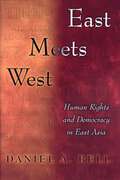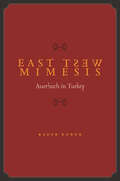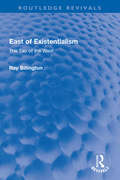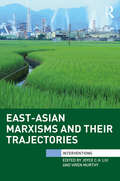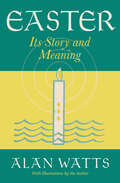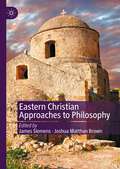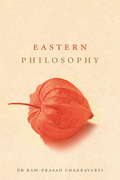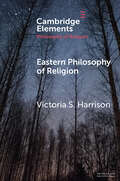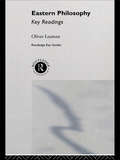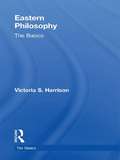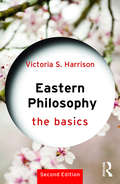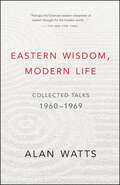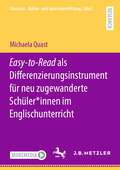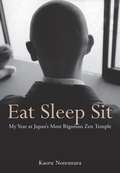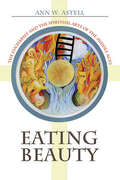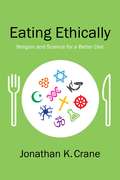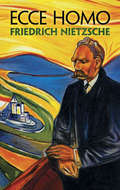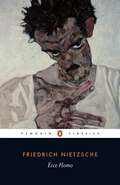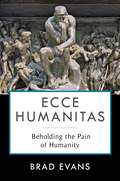- Table View
- List View
East Meets West: Human Rights and Democracy in East Asia
by Daniel A. BellIs liberal democracy a universal ideal? Proponents of "Asian values" argue that it is a distinctive product of the Western experience and that Western powers shouldn't try to push human rights and democracy onto Asian states. Liberal democrats in the West typically counter by questioning the motives of Asian critics, arguing that Asian leaders are merely trying to rationalize human-rights violations and authoritarian rule. In this book--written as a dialogue between an American democrat named Demo and three East Asian critics--Daniel A. Bell attempts to chart a middle ground between the extremes of the international debate on human rights and democracy. Bell criticizes the use of "Asian values" to justify oppression, but also draws on East Asian cultural traditions and contributions by contemporary intellectuals in East Asia to identify some powerful challenges to Western-style liberal democracy. In the first part of the book, Bell makes use of colorful stories and examples to show that there is a need to take into account East Asian perspectives on human rights and democracy. The second part--a fictitious dialogue between Demo and Asian senior statesman Lee Kuan Yew--examines the pros and cons of implementing Western-style democracy in Singapore. The third part of the book is an argument for an as-yet-unrealized Confucian political institution that justifiably differs from Western-style liberal democracy. This is a thought-provoking defense of distinctively East Asian challenges to Western-style liberal democracy that will stimulate interest and debate among students of political theory, Asian studies, and international human rights.
East West Mimesis: Auerbach in Turkey
by Kader KonukEast West Mimesis follows the plight of German-Jewish humanists who escaped Nazi persecution by seeking exile in a Muslim-dominated society. Kader Konuk asks why philologists like Erich Auerbach found humanism at home in Istanbul at the very moment it was banished from Europe. She challenges the notion of exile as synonymous with intellectual isolation and shows the reciprocal effects of German émigrés on Turkey's humanist reform movement. By making literary critical concepts productive for our understanding of Turkish cultural history, the book provides a new approach to the study of East-West relations. Central to the book is Erich Auerbach's Mimesis: The Representation of Reality in Western Literature, written in Istanbul after he fled Germany in 1936. Konuk draws on some of Auerbach's key concepts--figure as a way of conceptualizing history and mimesis as a means of representing reality--to show how Istanbul shaped Mimesis and to understand Turkey's humanist reform movement as a type of cultural mimesis.
East of Existentialism: The Tao of the West (Routledge Revivals)
by Ray BillingtonFirst published in 1990, East of Existentialism was written to explore new perspectives on eternal questions such as ‘Who am I?’, ‘Why am I here?’, and ‘Where am I going?’. The book brings together insights from existentialism in the West and Hinduism, Buddhism, and Taoism in the East, and presents practical case studies throughout to show the student how apparently abstruse themes relate to real-life situations. Divided into three parts, the first considers major Western contributions to the themes of human nature and destiny. The central section examines the connection between existentialism in the West and dominant philosophical schools in India and China. The last three chapters explore the relevance of Eastern ideas to Western thought, not only to provide philosophical theory but also to offer a greater understanding of moral and social dilemmas and of practical living. A full glossary explains the technical terms used in the book. East of Existentialism will appeal to those with an interest in philosophy and religious studies.
East-Asian Marxisms and Their Trajectories (Interventions)
by Viren Murthy Joyce C.H. LiuIn this volume, leading scholars from around the world suggest that radical ideologies have shaped complex historical processes in East Asia by examining how intellectuals and activists interpreted, rethought and criticized Marxism in East Asia. The contributors to this volume ask how we can use Marxism to understand East Asia in a global capitalist world, and where the problems that Marxism highlighted, including imperialism, domination and inequality, are increasingly prevalent. The volume draws on various disciplines to reinterpret Marx, and shed light on the complex dynamics of global capitalism in various historical/national contexts. The distinguished contributors illuminate, rethink and make accessible highly complex Marxist concepts, such as the question of class contradiction, the temporalities of capitalism, real and formal subsumption, relative surplus value and the commodity form, the question of class and the proletariat. At a time when people around the world are struggling to cope with the crises of global capitalism, this volume on regional responses to capitalism is especially welcome. It will be of interest to students and scholars of East Asian studies, social and political theory, sociology and globalization studies.
Easter: Its Story and Meaning
by Alan WattsTHE FORGOTTEN PAGAN ORIGINS OF CHRISTIANITY’S MOST EMBLEMATIC CELEBRATION “Easter — by whatever name it may be known — is a theme common to almost every religion and every people.” — Alan Watts Along with Christmas, Easter Sunday is one of the two most popular celebrations on the Church calendar. For millions of believers around the world, it encapsulates the central message of Christianity. Yet Easter has become associated with a perplexing jumble of non-Biblical customs: colorful eggs, chocolate rabbits, evening bonfires, children’s songs, mischievous games, and more. Philosopher Alan Watts proposes that these curiosities are vestiges of a tradition far older than Christianity. In Easter: Its Story and Meaning, Watts goes in search of the lost origins of Easter, taking readers with him on a kaleidoscopic tour of history, anthropology, and myth. He begins on the scorching plains of Bronze Age Mesopotamia, wanders the marble temples of imperial Rome, enters the glittering cathedrals of medieval Europe, and eventually lands in modern America. In the course of the journey, Watts unravels the multilayered symbolism of Easter and places the holiday within the broader context of world religions. He also delves into several tantalizing historical enigmas, such as: • Why is Christianity’s most sacred holiday named after a pagan goddess? • Is Jesus Christ historically unique, or is he just another example of the “dying-and-rising god” archetype common in antiquity? • How was the date of Easter calculated by the patriarchs of the early Church? • Where did the tradition of the Easter egg come from? (Could it be African?) The book closes on a lighthearted note, with a collection of weird and wonderful Easter folk traditions old and new. From beginning to end, Watts employs his keen intellect and vast erudition to uncover hidden connections between seemingly unrelated events. The result is a philosophical adventure that will enlighten readers of all religious backgrounds. Watts concludes that Easter is a universal celebration of nature’s eternal cycle of life, death, and rebirth — a celebration for all humanity.
Eastern Christian Approaches to Philosophy
by James Siemens Joshua Matthan BrownWith few exceptions, the field of Eastern Christian studies has primarily been concerned with historical-critical analysis, hermeneutics, and sociology. For the most part it has not attempted to bring Eastern Christian philosophy into serious engagement with contemporary thought. This volume seeks to redress the matter by bringing the Eastern Christian tradition into a meaningful dialogue with contemporary philosophy. It boasts a diverse group of scholars—specialists in ancient philosophy, analytic philosophy, and continental philosophy—who engage with a wide range of pressing issues. Among other things, it addresses such topics as contemporary atheism, the metaphysics of action, religious epistemology, the philosophy of language, bioethics, the philosophy of race, and human rights. In so doing, it aims to introduce contemporary readers to unique perspectives and novel arguments often overlooked by mainstream anglophone philosophy.
Eastern Philosophy
by Chakravarthi Ram-PrasadA magisterial overview of the philosophies of the East.'The time has come for global philosophy to move beyond the model where the West is at the centre of radiating spokes of comparison.' Challenging the notion that Western philosophy is the best or only yardstick against which to judge the so-called 'non-Western' philosophies, Chakravarthi Ram-Prasad sets up a lively debate in which the great thought systems of the East are engaged very much in their own terms. The author's impressive sweep takes him through South Asia east to China and Japan, encompassing 3000 years of philosophy and including the ancient philosophies of India, Jainism, Buddhism, Daoism and Confucianism. At the same time, Ram-Prasad dispels the romantic illusion that there is some common mystical 'wisdom tradition' that binds together the cultures of the East. His aim is to give a sense of the diversity and depth of these philosophical cultures, as well as their sophistication and originality; and to make comparisons between them to illuminate their varied yet potentially universal appeal.
Eastern Philosophy
by Chakravarthi Ram-PrasadA magisterial overview of the philosophies of the East.'The time has come for global philosophy to move beyond the model where the West is at the centre of radiating spokes of comparison.' Challenging the notion that Western philosophy is the best or only yardstick against which to judge the so-called 'non-Western' philosophies, Chakravarthi Ram-Prasad sets up a lively debate in which the great thought systems of the East are engaged very much in their own terms. The author's impressive sweep takes him through South Asia east to China and Japan, encompassing 3000 years of philosophy and including the ancient philosophies of India, Jainism, Buddhism, Daoism and Confucianism. At the same time, Ram-Prasad dispels the romantic illusion that there is some common mystical 'wisdom tradition' that binds together the cultures of the East. His aim is to give a sense of the diversity and depth of these philosophical cultures, as well as their sophistication and originality; and to make comparisons between them to illuminate their varied yet potentially universal appeal.
Eastern Philosophy of Religion (Elements in the Philosophy of Religion)
by Victoria S. HarrisonThis Element selectively examines a range of ideas and arguments drawn from the philosophical traditions of South and East Asia, focusing on those that are especially relevant to the philosophy of religion. The Element introduces key debates about the self and the nature of reality that unite the otherwise highly diverse philosophies of Indian and Chinese Buddhism, Hinduism, and Jainism. The emphasis of this Element is analytical rather than historical. Key issues are explained in a clear, precise, accessible manner, and with a view to their contemporary relevance to ongoing philosophical debates.
Eastern Philosophy: A guide to the wisdom and traditions of thought of India and the Far East
by Mel ThompsonTeach Yourself Eastern Philosophy examines key ideas that developed within the ancient civilisations of India and China. It presents a range of philosophies that both inform discussion of personal, moral and social issues and address the fundamental questions about the nature of reality and the place and purpose of human life within it.From the erotic images of Tantra to the simple precision of Zen, and from the social order in traditional Confucian teaching to the rich variety of Hindu ideas and lifestyles, Teach Yourself Eastern Philosophy provides a feast of ideas of universal relevance.Teach Yourself Eastern Philosophy:- Looks at the ethical and social implications of Eastern philosophy.- Gives key terms in their original language with full explananations.- Points to parallels with Western thought, where appropriate.- Provides essential background information for appreciating the religions of India and the Far East.
Eastern Philosophy: Key Readings (Routledge Key Guides)
by Oliver LeamanThrough key readings from primary and secondary sources this book communicates at first hand the principal features of a remarkable range of Eastern thought - from Buddhism, Confucianism, and Hinduism to Islam, Shinto, and Zoroastrianism. Passages from key texts guide the reader through over ninety major terms, from abhidharma to Zen.Material is drawn not only from such cornerstone texts as the Bhagavad-gita and the Lao-tzu, but also from modern writings on Eastern philosophy and religion.
Eastern Philosophy: The Basics (The Basics)
by Victoria S. HarrisonEastern Philosophy: The Basics is an essential introduction to major Indian and Chinese philosophies, both past and present. Exploring familiar metaphysical and ethical questions from the perspectives of different Eastern philosophies, including Confucianism, Daoism, and strands of Buddhism and Hinduism, this book covers key figures, issues, methods and concepts. Questions discussed include: What is the 'self'? Is human nature inherently good or bad? How is the mind related to the world? How can you live an authentic life? What is the fundamental nature of reality? Throughout the book the relationships between Eastern Philosophy, Western Philosophy and the questions reflective people ask within the contemporary world are brought to the fore. With timelines highlighting key figures and their contributions, a list of useful websites and further reading suggestions for each topic, this engaging overview of fundamental ideas in Eastern Philosophy is valuable reading for all students of philosophy and religion, especially those seeking to understand Eastern perspectives.
Eastern Philosophy: The Basics (The Basics)
by Victoria S. HarrisonEastern Philosophy: The Basics is an essential introduction to major Indian and Chinese philosophies, both past and present. Exploring familiar metaphysical and ethical questions from the perspectives offered by a range of eastern philosophies, including Confucianism, Daoism, the main Buddhist and Hindu philosophical schools, as well as Jainism, this book covers key figures, issues, methods and concepts. Questions discussed include: What is the ‘self’? Is human nature inherently good or bad? How is the mind related to the world? How can you live an authentic life? What is the fundamental nature of reality? With timelines highlighting key figures and their contributions, a list of useful websites, pronunciation guides and further reading suggestions, Eastern Philosophy: The Basics provides an engaging overview of fundamental ideas in eastern philosophy. The second edition has been thoroughly revised and updated to take account of the most recent scholarship. It includes study questions for each chapter, an updated bibliography, a new section on the Yijing and expanded discussion of Indian philosophies and their basis in experience. Eastern Philosophy: The Basics is valuable reading for all students of philosophy and religion, especially those seeking to understand eastern thought.
Eastern Wisdom, Modern Life: Collected Talks: 1960-1969
by Alan WattsAlan Watts introduced millions of Western readers to Zen and other Eastern philosophies. But he is also recognized as a brilliant commentator on Judeo-Christian traditions, as well as a celebrity philosopher who exemplified the ideas — and lifestyle — of the 1960s counterculture. In this compilation of controversial lectures that Watts delivered at American universities throughout the sixties, he challenges readers to reevaluate Western culture's most hallowed constructs. Watts treads the familiar ground of interpreting Eastern traditions, but he also covers new territory, exploring the counterculture's basis in the ancient tribal and shamanic cultures of Asia, Siberia, and the Americas. In the process, he addresses some of the era's most important questions: What is the nature of reality? How does an individual's relationship to society affect this reality? Filled with Watts's playful, provocative style, the talks show the remarkable scope of a philosopher at his prime, exploring and defining the sixties counterculture as only Alan Watts could.
Easy-to-Read als Differenzierungsinstrument für neu zugewanderte Schüler*innen im Englischunterricht (Literatur-, Kultur- und Sprachvermittlung: LiKuS)
by Michaela QuastIn einer Mixed-Methods-Studie werden elf neu zugewanderten Schüler*innen in der Jahrgangsstufe Einführungsphase am Gymnasium im Rahmen einer Unterrichtsreihe Texte in Easy-to-Read-Versionen (Deutsch: Leichte Sprache) vorgelegt und sowohl sprachliche/fachliche als auch emotionale/soziale Auswirkungen auf die Lernenden untersucht. Außerdem wird ein auf die Zielgruppe angepasstes, zweifach gestuftes Regelwerk für die Erstellung solcher Textversionen entwickelt und Rahmenbedingungen für dessen Einsatz konkretisiert. Ziel ist es, dass neu zugewanderten Schüler*innen, die u.U. wenig oder kaum Englisch können, aber aufgrund ihres Alters in eher fortgeschrittene Englischlerngruppen eingegliedert werden, dennoch die Möglichkeit haben, sich im Englischunterricht einzubringen und mit der peer group zu lernen. Dabei übernimmt das Easy-to-Read eine Brückenfunktion, bis dem Englischunterricht auf Regelniveau gefolgt werden kann.
Eat Sleep Sit: My Year at Japan's Most Rigorous Zen Temple
by Juliet Winters Carpenter Kaoru NonomuraAt the age of thirty, Kaoru Nonomura left his family, his girlfriend, and his job as a designer to undertake a year of ascetic training at Eiheiji, one of the most rigorous Zen training temples in Japan. This book is Nonomura's account of his experiences. He skillfully describes every aspect of training, including how to meditate, how to eat, how to wash, and even how to use the toilet, in a way that is easy to understand even for readers with no knowledge of Zen Buddhism. This first-person account also describes Nonomura's struggles in the face of beatings, hunger, exhaustion, fear, and loneliness, the comfort he draws from his friendships with the other trainees, and his quiet determination to give his life spiritual meaning.After writing Eat Sleep Sit, Kaoru Nonomura returned to his normal life as a designer, but his book has maintained its popularity in Japan, selling more than 100,000 copies since its first printing in 1996. Beautifully written, and a fascinating insight into a lifestyle of hardships that few people could endure, this is a book that will appeal to all those with an interest in Zen Buddhism and to anyone with an interest in the quest for spiritual growth.
Eat This Book
by Gary Steiner Dominique LestelIf we want to improve the treatment of animals, Dominique Lestel argues, we must acknowledge our evolutionary impulse to eat them, and we must expand our worldview to see how others consume meat ethically and sustainably. The position of vegans and vegetarians is unrealistic and exclusionary. Eat This Book calls at once for a renewed and vigorous defense of animal rights and a more open approach to meat eating that turns us into responsible carnivores.A leading French philosopher who has written extensively on animal agency and welfare, Lestel skillfully synthesizes Western philosophical views on the moral status of animals and holistic cosmologies that recognize human-animal reciprocity. Vegetarianism isolates humans from the world by refusing to accept that cruelty, violence, and conflicting interests are part of life. Lestel presents the carnivore's position as more coherently ethical, describing how meat-eaters assume completely, which is to say metabolically, their animal status, appreciating fully the life-giving power of animal flesh. Lestel vehemently condemns factory farming and the terrible footprint of industrial meat eating. His goal is to promote a kinship between humans and animals that we can all support and that in practice reminds us what it means to be tied inextricably to the world.
Eat This Book: A Carnivore's Manifesto (Critical Perspectives on Animals: Theory, Culture, Science, and Law)
by Dominique LestelIf we want to improve the treatment of animals, Dominique Lestel argues, we must acknowledge our evolutionary impulse to eat them and we must expand our worldview to see how others consume meat ethically and sustainably. The position of vegans and vegetarians is unrealistic and exclusionary. Eat This Book calls at once for a renewed and vigorous defense of animal rights and a more open approach to meat eating that turns us into responsible carnivores. Lestel skillfully synthesizes Western philosophical views on the moral status of animals and holistic cosmologies that recognize human-animal reciprocity. He shows that the carnivore's position is more coherently ethical than vegetarianism, which isolates humans from the world by treating cruelty, violence, and conflicting interests as phenomena outside of life. Describing how meat eaters assume completely—which is to say, metabolically—their animal status, Lestel opens our eyes to the vital relation between carnivores and animals and carnivores' genuine appreciation of animals' life-sustaining flesh. He vehemently condemns factory farming and the terrible footprint of industrial meat eating. His goal is to recreate a kinship between humans and animals that reminds us of what it means to be tied to the world.
Eating Anxiety: The Perils of Food Politics
by Chad LavinDebates about obesity are really about the meaning of responsibility. The trend toward local foods reflects the changing nature of space due to new communication technologies. Vegetarian theory capitalizes on biotechnology&’s challenge to the meaning of species. And food politics, as this book makes powerfully clear, is actually about the political anxieties surrounding globalization. In Eating Anxiety, Chad Lavin argues that our culture&’s obsession with diet, obesity, meat, and local foods enacts ideological and biopolitical responses to perceived threats to both individual and national sovereignty. Using the occasion of eating to examine assumptions about identity, objectivity, and sovereignty that underwrite so much political order, Lavin explains how food functions to help structure popular and philosophical understandings of the world and the place of humans within it. He introduces the concept of digestive subjectivity and shows how this offers valuable resources for rethinking cherished political ideals surrounding knowledge, democracy, and power. Exploring discourses of food politics, Eating Anxiety links the concerns of food—especially issues of sustainability, public health, and inequality—to the evolution of the world order and the possibilities for democratic rule. It forces us to question the significance of consumerist politics and—simultaneously—the relationship between politics and ethics, public and private.
Eating Beauty: The Eucharist and the Spiritual Arts of the Middle Ages
by Ann W. Astell"The enigmatic link between the natural and artistic beauty that is to be contemplated but not eaten, on the one hand, and the eucharistic beauty that is both seen (with the eyes of faith) and eaten, on the other, intrigues me and inspires this book. One cannot ask theo-aesthetic questions about the Eucharist without engaging fundamental questions about the relationship between beauty, art (broadly defined), and eating."—from Eating BeautyIn a remarkable book that is at once learned, startlingly original, and highly personal, Ann W. Astell explores the ambiguity of the phrase "eating beauty." The phrase evokes the destruction of beauty, the devouring mouth of the grave, the mouth of hell. To eat beauty is to destroy it. Yet in the case of the Eucharist the person of faith who eats the Host is transformed into beauty itself, literally incorporated into Christ. In this sense, Astell explains, the Eucharist was "productive of an entire 'way' of life, a virtuous life-form, an artwork, with Christ himself as the principal artist." The Eucharist established for the people of the Middle Ages distinctive schools of sanctity—Cistercian, Franciscan, Dominican, and Ignatian—whose members were united by the eucharistic sacrament that they received.Reading the lives of the saints not primarily as historical documents but as iconic expressions of original artworks fashioned by the eucharistic Christ, Astell puts the "faceless" Host in a dynamic relationship with these icons. With the advent of each new spirituality, the Christian idea of beauty expanded to include, first, the marred beauty of the saint and, finally, that of the church torn by division—an anti-aesthetic beauty embracing process, suffering, deformity, and disappearance, as well as the radiant lightness of the resurrected body. This astonishing work of intellectual and religious history is illustrated with telling artistic examples ranging from medieval manuscript illuminations to sculptures by Michelangelo and paintings by Salvador Dalí. Astell puts the lives of medieval saints in conversation with modern philosophers as disparate as Simone Weil and G. W. F. Hegel.
Eating Ethically: Religion and Science for a Better Diet
by Jonathan K. CraneFew activities are as essential to human flourishing as eating, and fewer still are as ethically fraught. Eating well is particularly confusing. We live amid excess, faced with conflicting recommendations, contradictory scientific studies, and complex moral, medical, and environmental consequences that influence our choices. A new eating strategy is urgently needed, one grounded in ethics, informed by biology, supported by philosophy and theology, and, ultimately, personally achievable.Eating Ethically argues persuasively for more adaptive eating practices. Drawing on religion, medicine, philosophy, cognitive science, art, ethics, and more, Jonathan K. Crane shows how distinguishing among the eater, the eaten, and the act of eating promotes a radical reorientation away from external cues and toward internal ones. This turn is vital for survival, according to classic philosophy on appetite and contemporary studies of satiety, metabolic science as well as metaphysics and religion. By intertwining ancient wisdom from Judaism, Christianity, and Islam with cutting-edge research, Crane concludes that ethical eating is a means to achieve both personal health and social cohesion. Grounded in science and tradition, Eating Ethically shows us what it truly means to eat well.
Ecce Homo
by Friedrich Nietzsche Anthony M. LudoviciFor the title of his autobiography, Friedrich Nietzsche chose Pilate's words upon discharging Christ to the mob: Ecce Homo, or "Behold the man." The original subtitle, How One Becomes What One Is, suggests a psychologically intriguing exploration of the philosopher's personal history. Nietzsche fulfills that promise with a dramatic summation of his life and career that turns conventional notions of autobiography inside out.Published posthumously in 1908, Ecce Homo was written in 1888 and completed just a few weeks before Nietzsche's complete mental collapse. Its outrageously egotistical review of the philosopher's life and works — featuring chapters called Why I Am So Wise and Why I Write Such Good Books — are redeemed from mere arrogance by masterful language and ever-relevant ideas. In addition to settling scores with his many personal and philosophical enemies (including Richard Wagner, German nationalism, and Christianity), Nietzsche emphasizes the importance of questioning traditional morality, establishing autonomy, and making a commitment to creativity.Essential reading for students of philosophy, this unique memoir is crucial to an understanding of Nietzsche's other works.
Ecce Homo: How One Becomes What One is
by Friedrich NietzscheIn late 1888, only weeks before his final collapse into madness, Nietzsche (1844-1900) set out to compose his autobiography, and Ecce Homo remains one of the most intriguing yet bizarre examples of the genre ever written. In this extraordinary work Nietzsche traces his life, work and development as a philosopher, examines the heroes he has identified with, struggled against and then overcome - Schopenhauer, Wagner, Socrates, Christ - and predicts the cataclysmic impact of his 'forthcoming revelation of all values'. Both self-celebrating and self-mocking, penetrating and strange, Ecce Homo gives the final, definitive expression to Nietzsche's main beliefs and is in every way his last testament.
Ecce Humanitas: Beholding the Pain of Humanity (Insurrections: Critical Studies in Religion, Politics, and Culture)
by Brad EvansThe very idea of humanity seems to be in crisis. Born in the ashes of devastation after the slaughter of millions, the liberal conception of humanity imagined a suffering victim in need of salvation. Today, this figure appears less and less capable of galvanizing the political imagination. But without it, how are we to respond to the inhumane violence that overwhelms our political and philosophical registers? How can we make sense of the violence that was carried out in the name of humanism? And how can we develop more ethical relations without becoming parasitic on the pain of others?Through a critical exploration of violence and the sacred, Ecce Humanitas recasts the fall of liberal humanism. Brad Evans offers a rich analysis of the changing nature of sacrificial violence, from its theological origins to the exhaustion of the victim in the contemporary world. He critiques the aestheticization that turns victims into sacred objects, sacrificial figures that demand response, perpetuating a cycle of violence that is seen as natural and inevitable. In novel readings of classic and contemporary works, Evans traces the sacralization of violence as well as art’s potential to incite resistance. Countering the continued annihilation of life, Ecce Humanitas calls for liberating the political imagination from the scene of sacrifice. A new aesthetics provides a form of transgressive witnessing that challenges the ubiquity of violence and allows us to go beyond humanism to imagine a truly liberated humanity.
Ecce homo
by Friedrich NietzscheEcce homo. Cómo se llega a ser lo que se es, resulta, sin duda alguna, el título más pertinente para la autobiografía del genial filósofo y pensador alemán Friedrich Nietzsche. Ecce homo, o "Aquí tienen al hombre", son las palabras con que Pilatos entrega a Jesucristo a la crucifixión, sin encontrar culpa en él, pero también sin poder torcer su destino, Ecce homo, así se autodefine el propio Nietzsche. "Cómo se llega a ser lo que se es" es simplemente el legado de alguien que supo asumir su propio destino, que supo estar a la altura de él y encarnarlo. Ecce homo se publicó en 1908, veinte años después de su redacción en 1888, y ocho después de la muerte del autor. En 1888 Nietzsche siente que no le queda mucho tiempo y, el 15 de octubre de ese año, el día que cumplía 44 años, decide "contarse su vida a sí mismo"; desde ese día, hasta mediados de noviembre, trabajará intensamente en esta peculiarísima autobiografía.
